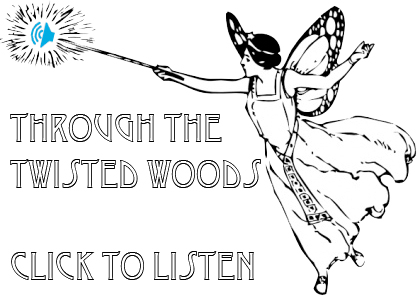By Sara Cleto
When we first founded TTW, I knew I wanted to interview and feature the work of Erin Kathleen Bahl, a digital humanities scholar with an interest in folklore. Her interdisciplinary scholarship is often, at its core, about how we tell stories through text, images, objects, memory, and more. Her beautiful webcomic “Citrus and Canaries: The Witch’s Orchard Charm,” which she created for TTW, can be viewed here.
Through The Twisted Woods: Tell us a little about yourself! What kind of work do you do?
Erin Kathleen Bahl: I am a PhD candidate working at the intersections of digital media, composition, and folklore. I’m especially interested in varying forms of visual narrative; my creative work most definitely informs and is informed by my scholarly work in return. I’ve worked with collaborators on projects involving magical girl anime, 3D motion capture of classical Indian dance, and digital remixes of traditional fairy tales such as “The Singing, Springing Lark” and “The Bremen Town Musicians.” Ultimately, I’m interested in acts of creative making across a range of media environments, and in creating knowledge and telling stories with digital technologies.
TTW: How did you become interested in traditional narratives? And how did you become interested in digital media?
Erin Kathleen Bahl: I was extremely fortunate that my small-town middle/high school offered a storytelling category on our speech and debate team. I competed as a storyteller for six years; the repertoire included a range of traditional stories such as folk tales, fairy tales, and wonder tales from around the world. It was incredible to me how one person could create an entire world for their audience with just their face, voice, and body, and I loved to see how each storyteller brought new life to the tale based on their unique style and individual interpretation.
My interests in digital media were sparked via Wagnerian opera. I worked on Siegfried for several months as a dramaturgy intern at the Hannover State Opera House and was entranced by Wagner’s theories of Gesamtkunstwerk, or “total artwork” that incorporates multiple media and sensory channels. Digital media became a route for me to explore multimedia possibilities as an individual composer, without the resources afforded by a full opera house.
TTW: What are your thoughts on mixing folk and fairy tales and digital media? What inspires you to pursue this kind of work?
Erin Kathleen Bahl: I’m most definitely inspired by the creative community around fairy tales that I’ve encountered both in person and online. There are so many individuals doing beautiful, intriguing, exquisitely crafted fairy tale-related work in a range of contexts, from poetry to jewelry to fashion to music and more! My creative making happens to be primarily digital, and I hope to contribute in my own way alongside others’ inspiring, magical work.
TTW: Is it different to work in that kind of media with such old materials as your start? Why do it? Does it lend itself better to presenting the unheard stories somehow?
Erin Kathleen Bahl: I don’t necessarily see a sharp break between “new” media and “old” story materials—in fifty years or so (or five, even!) the tools I’m working with now may very well be considered ancient! I still feel so new to digital composing in many ways that it’s very comforting to work with familiar stories as a starting point. Working with a fairy tale gives me an underlying structure to rely on in generating ideas, from which I can then feel free to experiment with images, text, and panel structure. I hope to be one of many contemporary voices in dialogue with a vibrant tradition of creative storytelling, in which familiar narratives move across the media forms available in a given time and place.
TTW: Do you feel that oral storytelling and digital media are connected? How?
Erin Kathleen Bahl: In some ways, yes! Both are tools that can be used to create one instance of variation on a traditional source tale. Both deliberately use multiple mediating channels to design an audience’s experience of a story; an oral storyteller might make use of voice, face, and gesture, for example, while a digital media composer might choose to include visual, textual, audio, or video elements. With multiple mediating channels, too, come multiple potential channels of access, which is especially important in working so that audience members of varying abilities have equally rich access to the narrative experience.
TTW: Do you have any thoughts about how digital media can make traditional narratives and fairy tales more accessible?
Erin Kathleen Bahl: I mentioned access for differing abilities briefly above; I also think digital technologies can make traditional narratives more accessible through increased ease of transmission and distribution. Stories from around the world, from multiple traditions and cultures, can be read and shared much more easily today than a century ago. With the online groups I’m part of, additionally, I can see how other individuals may have interpreted and responded to a story differently based on their own unique perspectives and experiences. I come to understand and appreciate more fully the complex layers at the hearts of familiar tales when I have the chance to look at them through other peoples’ eyes.
TTW: What is your favorite fairy tale?
Erin Kathleen Bahl: That’s a hard one! I would have to say “Thousandfurs”—as someone who wears a lot of dresses and skirts, I’ve always loved the imagery of dresses as golden as the sun, as silvery as the moon, and as glittering as the stars. (I would totally wear the golden one every day!)
TTW: What inspired you to create the piece you made for TTW?
Erin Kathleen Bahl: I tend to be inspired by a single image that captures my attention, and that I want to explore in more detail. In the case of this comic, what grabbed me first was the idea of the witch in an orchard full of canaries (i.e., what if the canaries emerging from the stolen oranges in the source tale were not exceptions, but part of a larger flock?) I knew I wanted to build up to that moment, and as I worked the piece slowly picked up more sinister undertones—by the end, the explosion of canaries was no longer a moment of delirious joy, but a fleeting, fragile moment of sunshine in a cold world. I’d like for my work to be rich in suggestion and short on explanation, though, so I’m curious to hear how others respond to and interpret the piece!
TTW: Where would you like to see digital art inspired by folklore go next? Are there any projects you’d like to do or that you’d like to see happen?
Erin Kathleen Bahl: I’d love to see it go everywhere! I’m currently working with Brittany Warman on a creative web-piece called “Facets”—we combine poetry, illustrations, and web design in varying arrangements to present a critical/creative reading of “The Singing, Springing Lark.” I’m also working with Margaret Price on a creative digital scholarly project that uses “The Bremen Town Musicians” to explore audio description of visual narrative as an integral part of a more broadly accessible storytelling experience. In general, I’d love to see more collaborative online spaces like Through the Twisted Woods that fuse scholarship and art, and that are committed to foregrounding marginalized voices in fairy tale and folk narratives. I also hope to see (and help create!) more short-form comics, print or digital, that engage traditional narratives as source material or stylistic inspiration—there’s a lot of great work out there, but there’s always more to explore!

Erin Kathleen Bahl is a doctoral candidate in the English department at the Ohio State University studying digital media, composition, and folklore. Her research investigates the possibilities that new media and digital technologies offer for creating knowledge and telling stories. She is currently working on a dissertation exploring processes of invention and design in composing new media scholarship. Her work has been published in The Nashville Review, Composition Studies, Humanities Journal, Harlot of the Arts, Signs and Media, Showcasing the Best of CIWIC/DMAC, and Computers and Composition (print and online).





